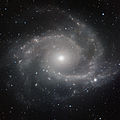NGC 2997
| Galaxie NGC 2997 | |
|---|---|
![Aufnahme mit einem Ritchey-Chretien-Teleskop in Chile mit einer 1 m Apertur[1]](http://upload.wikimedia.org/wikipedia/commons/thumb/4/4c/N2997s.jpg/300px-N2997s.jpg) | |
| Aufnahme mit einem Ritchey-Chretien-Teleskop in Chile mit einer 1 m Apertur[1] | |
| AladinLite | |
| Sternbild | Luftpumpe |
| Position Äquinoktium: J2000.0, Epoche: J2000.0 | |
| Rektaszension | 09h 45m 38,8s[2] |
| Deklination | -31° 11′ 28″ [2] |
| Erscheinungsbild | |
| Morphologischer Typ | SA(s)c [2][3] |
| Helligkeit (visuell) | 9,4 mag [3] |
| Helligkeit (B-Band) | 10,1 mag [3] |
| Winkelausdehnung | 8,9′ × 6,8′ [3] |
| Positionswinkel | 110° [3] |
| Flächenhelligkeit | 13,7 mag/arcmin² [3] |
| Physikalische Daten | |
| Zugehörigkeit | NGC 2997-Gruppe LGG 180 [2][4] |
| Rotverschiebung | 0,003633 ± 0,000003 [2] |
| Radialgeschwindigkeit | (1089 ± 1) km/s [2] |
| Hubbledistanz vrad / H0 | (39 ± 3) · 106 Lj (11,9 ± 0,8) Mpc [2] |
| Geschichte | |
| Entdeckung | Wilhelm Herschel |
| Entdeckungsdatum | 4. März 1793 |
| Katalogbezeichnungen | |
| NGC 2997 • UGC A 181 • PGC 27978 • ESO 434-035 • MCG -05-23-012 • 2MASX J09453879-3111279 • SGC 094328-3057.6 • GC 1923 • H V 50 • h 3188 • HIPASS J0945-31 • LDCE 683 NED004 | |
NGC 2997 ist eine Spiralgalaxie vom Hubble-Typ Sc im Sternbild Antlia am Südsternhimmel. Sie ist schätzungsweise 39 Millionen Lichtjahre von der Milchstraße entfernt und hat einen Durchmesser von etwa 120.000 Lj.
Im selben Himmelsareal befinden sich u. a. die Galaxien NGC 3001 und IC 2507.
Die Supernovae SN 2003jg (Typ-Ib/c) und SN 2008eh wurden hier beobachtet.[5]
Das Objekt wurde am 4. März 1793 von dem deutsch-britischen Astronomen Wilhelm Herschel entdeckt.[6]
Infrarotaufnahme mit HAWK-I des Very Large Telescope der ESO
Detailaufnahme mit FORS1 des Very Large Telescope, die Bildseitenlänge entspricht 3,4 Bogenminuten.
Weblinks
Einzelnachweise
Auf dieser Seite verwendete Medien
Autor/Urheber: ESO/P. Grosbøl, Lizenz: CC BY 4.0
This image, NGC 2997, is a spiral galaxy roughly 30 million light-years away in the constellation of Antlia
(the Air Pump). NGC 2997 is the brightest member of a group of galaxies of the same name in the Local Supercluster of galaxies. Our own Local Group, of which the Milky Way is a member, is itself also part of the Local Supercluster.
The image was made in infrared light with the HAWK-I camera on ESO’s Very Large Telescope at Paranal Observatory in Chile. HAWK-I is one of the most powerful infrared imagers in the world, and this is one of the sharpest and most detailed pictures of this galaxy ever taken from Earth. The filters used were Y (shown here in blue), J (in green), H (in orange), and K (in red). The field of view of the image is about 6.4 arcminutes.Autor/Urheber: ESO, Lizenz: CC BY 4.0
This is a three-colour composite of the spiral galaxy NGC 2997 in the southern constellation Antlia (The Air Pump), obtained with the VLT UT1 and FORS1 in the morning of March 5, 1999. It is based on three exposures in V (green; 3 min; image quality 0.35 arcsec), R (red; 3 min; 0.34 arcsec) and I (near-infrared; 5 min; 0.25 arcsec) bands, with the Moon above the horizon. The field measures 3.4 x 3.4 arcmin 2 or, at the distance of the galaxy (about 55 million light-years), 55,000 x 55,000 light-years. FORS1 was operated in high-resolution imaging mode; the pixel size was 0.1 arsec. North is down and East is left.
- ID
- phot-17a-99
- Press Release
- 06/99
- Object
- NGC 2997
- Telescope
- UT1/Antu
- Instrument
- FORS1
- Size
- 2030 x 2030
- Credit
- ESO
Autor/Urheber: Credit Line and Copyright Adam Block/ChileScope, Lizenz: CC BY-SA 3.0 us
NGC 2997
Picture Details:
Optics ChileScope 1.0m Telescope
Camera FLI Proline PL16803
Filters AstroDon Generation II
Dates Spring 2018
Location ChileScope, Chilean Andes, near Ovalle
Exposure LRGB = 6 : 5 : 6 : 5 Hours
Acquisition ChileScope Software, Astronomer Control Panel (ACP/ DC3 Dreams), Maxim DL/CCD (Cyanogen)
Processing PixInsight
Credit Line and Copyright
Adam Block/ChileScope
. 






